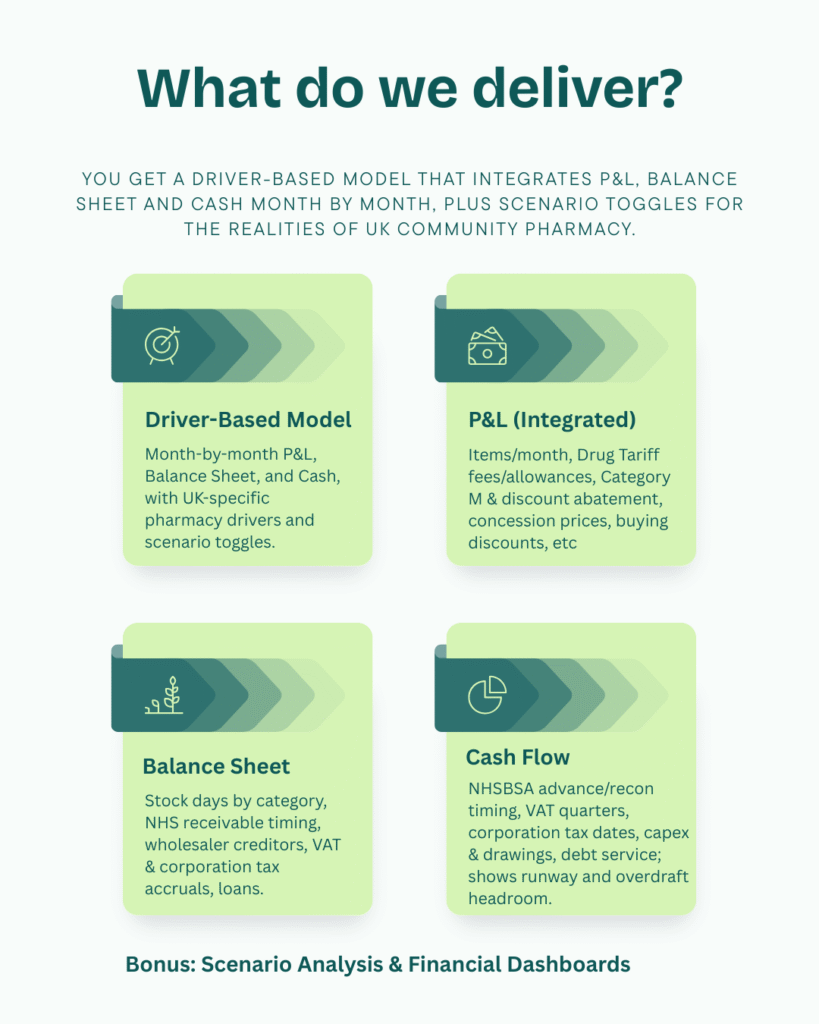A 24-month, three-statement financial forecast protects your pharmacy from current and ongoing Category M price margin reduction shocks. By showing—in advance—how reimbursement changes, wage inflation and service mix will affect future profits, working capital and cash. For the period from January 2025 to October 2025, the price changes have resulted in a -£63 million decrease in price reimbursement for approximately 600 core medicines (Category M Medicines) to pharmacies UK wide. This article aims to equip your pharmacy with the scenario levers to act as the profit margin from these products disappears.
Led by Buhir Rafiq MAAT (pharmacy-specialised accountant and Virtual Finance Director), RX Virtual Finance builds an integrated Profit & Loss (P&L) , Balance Sheet and Cashflow model with pharmacy-specific drivers (Drug Tariff, Category M, concessionary prices, discount abatement, NHSBSA timing), so rota, stock, services and lender conversations are all decided with numbers, not guesswork.
- Outcome: clear runway, covenant headroom, rota and locum plan, buying margin actions, service profitability by store.
- Method: driver-based model (monthly), scenario toggles, variance workflow, and a simple governance cadence you can run in 60 minutes a month.
- Audience: independents, multi-site groups, new buyers, LPC-active pharmacies planning Pharmacy First, NMS, CPCS, DMS and vaccination growth.
Speak to a Pharmacy Virtual Finance Director
Key takeaways
- Protect margin with foresight, not hindsight. A pharmacy-specific, three-statement forecast turns Category M and price concessions into controllable scenarios, not last-minute shocks.
- Model what actually drives your numbers. Use items/month, reimbursement/allowances, discount abatement, generic vs brands mix, wholesaler discount tiers, locum rate curves, NLW uplift, and NHSBSA payment timing to predict reality.
- Decide quickly with scenario sliders. Run Downside (Category M cut + locum spike), Upside (Pharmacy First + NMS growth + buying margin improvement), and Refinance (DSCR and headroom) in minutes.
- Convert profit into cash. Tie stock days, creditor days, VAT calendar, corporation tax, capex and drawings to one cash view so runway and overdraft headroom are visible.
- Keep it alive monthly. Actuals → variance → action log under a Pharmacy Virtual Finance Director keeps forecasts honest and decisions fast.
The October Category M price margins have been cut again by £16.3 million through a downward margin adjustment. Added to the Downward margin adjustments of £13 million in the July Category M Adjustment. Making Pharmacies worse off.
The Community Pharmacy England reported in October 2025 that it estimates this will reduce overall reimbursement by approximately £77 million per quarter for like-for-like Category M medicines.
Before this adjustment to Category M medicine reimbursement pricing in January 2025, it cost pharmacies £34 million nationwide—approximately £1,100 per pharmacy.
The Community Pharmacy England continues to lobby the Department of Health (DHSC), highlighting that pharmacy businesses face unsustainable financial pressure and can’t absorb more cuts. Many products are reimbursed at unsustainable prices, risking patient access to medicines as pharmacies struggle to stock core items.
Risks of even further cuts.
As of October 2025, several converging factors could trigger another reduction in pharmacy reimbursement prices, particularly for Category M products:
Industry Investment Concerns – Major pharmaceutical companies, including Merck (£1 billion investment on September 25 cancelled) and AstraZeneca (£200 million investment on September 25 paused), are scaling back UK investment, citing insufficient government support and regulatory barriers to entry.
US Market Pressures – Due to tariffs – Pharmaceutical companies face increasing pressure to prioritise investment at sites within the US market.
Government Budget Deficit – The UK faces a substantial £62 billion budget deficit for the year ending August 2025, as reported by the ONS, creating pressure to identify new revenue sources.
Competitiveness Gap – The UK government faces mounting pressure to increase investment in pharmaceutical manufacturing, research, and advanced technologies. The industry is struggling compared to European counterparts who benefit from stronger government backing.
These factors create a concerning environment where the government may again look to reduce Category M reimbursement rates to pharmacies as a means of addressing budgetary pressures.
Common Questions
How do Category M changes affect my margin forecast?
Category M alters retained margin on generics; the model applies per-item pence changes and % retained-margin shifts across items/month to show gross margin movement by month, with discount abatement and concessionary price overlays for realistic pharmacy economics.
What wage inflation and locum assumptions should I use this year?
Use a National Living Wage (NLW) uplift scenario plus a locum rate sensitivity curve linked to rota coverage and seasonality; the model converts those inputs into staff cost per item, overtime pressure and EBITDA/Cash impact.
Can the model show Pharmacy First/NMS profitability at store level?
Yes. It treats Pharmacy First, NMS, CPCS, DMS, Hypertension Case-Finding, contraception and vaccines as driver blocks (volume, fee/consultation, uptake ramp, staff minutes) and reports service margin and throughput per site.
How are NHSBSA payment timings reflected in the cash flow report?
The cash forecast mirrors NHSBSA Schedule of Payments (advance vs reconciliation), shifting receipts to the actual month cash lands, then layers VAT and corporation tax calendars so runway is real, not accrual-based.
Will this help with bank refinancing or an acquisition?
Yes. Lenders want DSCR, runway, covenant headroom and scenario resilience; the pack includes lender-ready charts, assumptions and downside mitigation for conversations on overdrafts, term loans or acquisitions.
Can you maintain the model monthly as my Pharmacy Virtual Finance Director?
Yes. We run a month-end variance review, update drivers, keep the action log, and chair a 45–60 min finance huddle so owners and area managers execute fast without drowning in spreadsheets.

Who is this forecast for—and what decisions will it help you make?
This forecast is for independent pharmacies, multi-site groups, new buyers and LPC-active stores that need a 24-month view to make rota, buying, services and funding decisions with confidence. You decide rota hours and locum cover, stock strategy (fast vs slow movers), service expansion (Pharmacy First, NMS, flu/Covid, PGDs), and refinancing with a clear read on cash and covenants.
- New buyers: test bank cases, TOC (transfer of contract) assumptions, and first-year staffing before you commit.
- Independents: stabilise cash during Category M fluctuation and energy seasonality.
- Groups: standardise site-level driver packs; compare items per labour hour and service minutes per consultation across branches.
What do you get with a 24-month, 3-statement pharmacy forecast?
You get a driver-based model that integrates P&L, Balance Sheet and Cash month by month, plus scenario toggles for the realities of UK community pharmacy.

- Integrated Profit & Loss (P&L): items/month, Drug Tariff fees/allowances, Category M/discount abatement, concessionary prices, buying discounts, services income, staff costs (NLW + locum), overheads, .
- Balance Sheet: stock levels (days on hand by category), NHS receivable timing, wholesaler creditors, VAT and corporation tax accruals, loans & EBITDA.
- Cash: NHSBSA advance/recon timing, VAT quarters, corporation tax dates, capex and drawings, debt service; outputs runway and overdraft headroom.
- Scenarios: Category M slider (±p/item & % retained margin), Wage inflation slider (NLW uplift + locum curve), Service growth drivers (Pharmacy First/NMS/CPCS volumes), optional concession volatility and wholesaler discount changes.
- Dashboards: liquidity runway, covenant headroom, items/month trend, gross margin bridge, service profitability, staff cost per item.
Which pharmacy-specific drivers shape revenue and gross margin in the model?
Revenue and gross margin are shaped by NHS dispensing economics, OTC/private services, and buying margin. We model each with realistic inputs and references to EPS endorsing accuracy and Drug Tariff mechanics.
- NHS dispensing (core): items/month, single activity fee assumptions, retained margin via Category M, discount abatement, price concessions, generic vs brands mix, endorsing accuracy (to avoid leakage).
- Retail/OTC & private services: standard-rated OTC basket; PGDs/travel clinic, flu/Covid jabs, ear care, weight-management; price/volume/seasonality.
- Advanced services: Pharmacy First, NMS, CPCS, DMS, Hypertension Case-Finding, contraception service—each with fee per consultation, expected throughput, staff minutes per consultation and uptake ramp.
- Buying margin: wholesaler discount tiers, direct generic deals, shortage premiums, split lines vs bulk, and supplier rebates.
How are staff costs, premises and overheads modelled for realism?
Costs are modelled from the rota up, not as flat percentages, so wage inflation and locum scarcity translate into real-world cash impact.
- Staff costs: pharmacist/ACT/technician/dispensers mix, NLW uplifts, locum rate curves (seasonality and scarcity), training time, sickness cover. The model shows staff cost per item and minutes per service.
- Premises: rent/leases, business rates, utilities with energy seasonality, maintenance and compliance (fridges, GPhC-related costs).
- Overheads: PMR system, NHSBSA charges, delivery mileage, insurance, waste collection, SaaS creep (bookings, rota, analytics tools).
- Scenarios: +X% NLW, locum spike during holidays, +Y% energy uplift in winter.
How does the model convert profit into cash for the next 24 months?
The model converts profit into cash by wiring stock days, creditor days, tax calendars and NHSBSA timing into one cash ladder.
- Working capital: stock days (fast vs slow movers), wholesaler creditor days, NHS debtors profile; “what-if” for direct generics vs mainline mix.
- NHSBSA timing: advance and reconciliation cash months mapped to expected activity.
- Taxes: VAT quarters with zero-rated Rx vs standard-rated OTC/PGDs and partial exemption where relevant; corporation tax schedule aligned to profits.
- Outputs: weekly runway proxy, overdraft utilisation, stress-test breach markers, DSCR and covenant headroom overlays for lenders.
How do we simulate Category M shocks, wage inflation and service growth safely?
We simulate shocks safely with scenario sliders tied to the three statements, so a change in reimbursement or wages flows through gross margin, EBITDA, working capital and cash automatically.
- Category M shock slider: apply ±p per item and retained-margin % to generics; see gross margin bridge and cash effect month by month.
- Wage inflation slider: apply NLW uplift plus a locum rate curve; see staff cost per item and rota gaps; test mitigation (service price, hours).
- Service growth drivers: run Pharmacy First/NMS/CPCS volume and fee scenarios with ramp-up curves and staff minutes; view service P&L and cash.
- Optional shocks: concession volatility, wholesaler discount tier change, delivery/fuel spikes, equipment failure capex.
Which scenarios should every pharmacy run before year-end?
Every pharmacy should run four standard scenarios to inform rota, stock and lender discussions. We provide a Scenario Guide (PDF) inside the package.
- Base Case: current items/month, known NLW uplift, present service volumes, current discounts; verify runway and headroom.
- Downside: Category M reduction + price concessions + locum rate spike; identify the month headroom turns red; list mitigation levers (buying, hours, mix).
- Upside: Pharmacy First + NMS growth + improved buying discounts; check incremental EBITDA/Cash and working-capital needs.
- Refinance: map DSCR, covenant headroom, overdraft vs term mix; generate lender-ready charts.
How will a Pharmacy Virtual Finance Director keep this forecast alive each month?
A Pharmacy Virtual Finance Director keeps the forecast alive with a light, repeatable cadence that owners and area managers can follow without extra admin.
- Month-end actuals: import actual P&L and cash; reconcile NHS receipts and major variances.
- Variance to forecast: explain items/month, buying margin, staff hours, services throughput; tag root causes.
- Action log: 30-day actions—rota optimisation, buying changes, service throughput targets, stock reduction, supplier negotiations.
- Quarterly review: service mix, supplier terms, energy contracts, capital needs; update lender/board snapshot.
What exactly is delivered and how do we implement it?
We deliver the model, the dashboards, the playbook—and we make sure your team can run it.
- Deliverables: custom Excel/Sheets model, visual dashboard, Scenario Pack, Assumptions Log, and a short how-to video.
- Optional integration: accounting system + bank feed for rolling updates and faster month-end.
- Timeline: discovery call → data request (items, fees, staff/rota, utilities, VAT/corp tax, wholesaler terms) → draft model → review workshop → go-live → month-one variance review.
What results should you expect in the first 90 days?
By day 90 you should expect decisions and measurable gains, not just a neat file.
- Clear cash visibility: runway and overdraft headroom mapped for 24 months.
- Rota/wage plan aligned to demand: hours and locum cover shaped by items and service minutes.
- Service P&L clarity: throughput and margin for Pharmacy First/NMS/CPCS; targets agreed per store.
- Buying margin actions: discount tier strategy; direct vs mainline mix; concession handling.
- Lender-ready pack: DSCR, covenant headroom, downside plan; stronger position for refinancing or growth.
Mini snapshots (anonymised):
- Three-site group: Downside Category M run revealed a February headroom dip; rota trimmed 6%, direct generics expanded; runway extended by 7 weeks.
- Single store with strong services: Pharmacy First and NMS ramp moved EBITDA +£4.8k/qtr; staff minutes re-balanced from dispensing to services without extra locum spend.
- Buyer case: Bank approved facility after DSCR and downside proof; completion timed to avoid a VAT squeeze month.
What components are inside the P&L, Balance Sheet and Cash forecasts?
You can see the entire pharmacy business on one screen, by month, for two years.
- P&L: items/month, Drug Tariff fees & allowances, Category M & discount abatement, concessionary prices, buying discounts/rebates, OTC/PGDs/private clinics, staff costs (NLW + locum), premises & overheads, EBITDA.
- Balance Sheet: stock (by category), NHS receivables, wholesaler creditors, VAT/corp tax accruals, loans, director balances.
- Cash: NHSBSA advance/recon timing, VAT/corporation tax payments, capex pipeline, drawings, debt service; runway and headroom outputs.
Light scenario guide (at a glance)
You don’t need a long workshop to get value; you need the right four moves.
- If Category M drops: cut slow-moving stock, push direct generics, review endorsing accuracy, accelerate services with positive staff minutes economics.
- If locum rates spike: re-shape rota (ACT utilisation), shift non-peak tasks, bring forward training to reduce dependence in peak months.
- If services grow: protect throughput (booking/admin minutes), standardise consultation templates, tweak pricing for private services.
- If refinancing: present DSCR with downside overlays, stabilise working capital days, and show lender a living forecast rhythm.
Why choose RX Virtual Finance?
Choose RX Virtual Finance if you want pharmacy-specific models run by a senior accountant who knows Category M, Drug Tariff, NHSBSA timing and the service mix that makes real money. You get a plan that owners, managers and lenders all understand—and a team that keeps it current.
- Pharmacy expertise: economics of dispensing, services and buying.
- Action bias: variance-to-action within the same meeting.
- Calm change: small, compounding improvements instead of disruptive resets.
- Continuity: we can operate as your Pharmacy Virtual Finance Director month to month.
FAQs
What are Category M Medicines?
Category M medicines are over 600 commonly dispensed drugs whose reimbursement prices are set by the Department of Health and Social Care (DHSC) every quarter. The system uses sales data from manufacturers and dispensing volumes to calculate fair prices that include a guaranteed profit margin for pharmacies. Prices are adjusted quarterly to correct any differences between estimated and actual costs. As margins between NHS reimbursements and Pharmacy wholesale costs decrease. Pharmacies struggle to make any money from many of these items.
How quickly can you implement the 24-month forecast?
Most pharmacies go live in 10–14 days once baseline data lands (items/fees, rota, utilities, VAT/corp tax, wholesaler terms). We run a review workshop and ship the Scenario Guide with the dashboard.
Can you handle partial exemption for VAT if we expand private services?
Yes. The model separates zero-rated Rx and standard-rated OTC/PGDs/private clinics, flags partial exemption considerations, and schedules VAT cash flows realistically.
Do you cover energy seasonality and delivery costs?
Yes. Energy has a seasonality curve and delivery/fuel is a driver you can adjust; both flow through to EBITDA and Cash.
Can you integrate bank feeds and my accounting system?
Yes, if you want rolling updates. Many owners start with manual updates for the first two cycles, then automate once the cadence is bedded in.
Will this work for a group with 3–10 sites?
Yes. We provide site-level driver packs, consolidated reports, and comparisons for items per labour hour, service minutes per consultation, and margin differences.
What if the Drug Tariff or Category M changes mid-cycle?
Update the Category M slider and relevant fees; the model rolls the change through gross margin, working capital and cash automatically.
Can you help with bank refinancing or acquisition financials?
Yes. The package includes lender-ready DSCR, headroom and downside charts, with commentary. For acquisitions, we can extend to buyer models and diligence.




